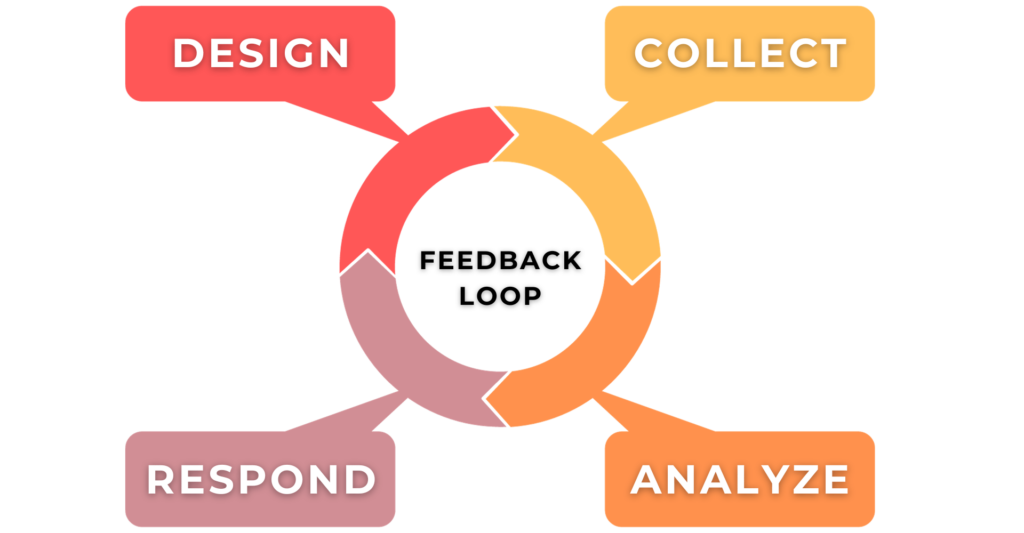Managing feedback and engaging participants are the two most significant challenges in training program evaluation. What strategy should you take to guarantee that the evaluation is tailored to the participants and gives a thorough understanding of their perspectives? Especially that the PwC report “Millenials At Work” states that over 75% of respondents believe feedback is valuable. About 45% also value feedback from their colleagues, not just the boss/trainer.
In this article, you will learn how to gather extensive input to improve training evaluation methods.
What Is Training Program Evaluation?
Training program evaluations are a systematic approach to assessing the effectiveness and efficiency of training initiatives. It’s fundamental to determine whether the training meets its intended objectives and contributes to organizational goals. This process involves setting clear benchmarks and using qualitative and quantitative measures to gather data.
Key components of training program evaluations include assessing learner satisfaction, knowledge acquisition, and behavior change. The goal is to provide actionable insights, ensuring the training aligns with individual and organizational needs. Organizations can make informed decisions about future training investments, modifications, and overall strategy by regularly evaluating training programs.
The Role of Feedback Loops
How should we understand feedback loops? Let’s say they are like a constant conversation. Trainees provide feedback on what they have learned, and trainers use this information to improve future training. After analyzing the feedback, the trainer introduces appropriate training methods or content changes.
Feedback loops are crucial in training program evaluations. They help shape training according to the needs and experiences of participants. This consequently leads to more effective and relevant learning outcomes. Regular and mutual communication also strengthens engagement and boosts performance among training participants.
How To Create A Feedback Loop?
As we already know, feedback loops are integral to continuously improving training programs, making them more effective and relevant. This process involves a series of actions and requires knowledge of the feedback loop structure. A standard feedback loop has four key stages:
- designing queries,
- collecting participants’ feedback,
- analyzing the information,
- acting on the findings,
- (optional) updating users about the changes made.

To be able to complete this classic pattern, it is worth using various tool which help in training program evaluations. The implementation of a comprehensive learning management system, which includes an integrated tool for collecting information from trainees about their impressions after the training, may also be invaluable. Here you can find some examples of tools and methods to gather more impactful insights:
Interview & In-App Surveys
But how to create a feedback loop in training program evaluations? To obtain objective results, you should employ techniques like interviews and in-app surveys. First, you should segment users to target the right audience with relevant queries. There, you should input questions to gather active and passive feedback. It will increase the likelihood of higher response rates and offer users various avenues to express their opinions.
Contextual Surveys, Tagging & Tracking
To get feedback on specific training elements, use contextual surveys. They can be implemented in the application to run when the user is engaged in a given function. When creating a feedback loop, use tagging and tracking tools to help you identify the leading causes of possible problems.
Automated Messages
What’s more? A well-created feedback loop should also include a function to confirm user opinions. Automated email responses and messages in the application or LMS will definitely help. Moreover, you can use these tools to inform training participants about changes made based on their feedback. However, since it only reaches active users, it is worth supplementing it with communication in other channels.
How To Implement Feedback Loops In Training Program Evaluations?
To effectively implement feedback loops in training evaluations, set clear training objectives for the feedback process aligned with the training program’s goals. This approach upgrades the training program’s effectiveness and ensures it evolves to meet the changing needs of participants. Moreover:
- Encourage open and honest communication by creating a safe space for participants to share their thoughts and experiences.
- Use various tools like surveys, focus groups, and direct observations to gather comprehensive feedback.
- Analyze this feedback to identify areas of success and those needing improvement. Integrating these insights into the training design is critical; it allows for a personalized learning, ensuring the program remains relevant and impactful.
- Make regular updates based on feedback to help create a dynamic and adaptive learning environment.
Best Practices for Integrating Feedback Loops in Training Program Evaluations
Effectively integrating feedback loops in training program evaluations includes several best practices that ensure meaningful and productive feedback. First, it is important to establish clear goals for both the training and feedback processes:
- In the case of training, goals may include developing specific skills, improving performance, or supporting behavioral change.
- In the feedback process, goals should focus on assessing trainee understanding, identifying gaps in training content, and measuring the application of acquired skills and level of engagement.
Use Tools & LMS
To obtain feedback, you can use various digital tools and platforms, like LMS. This will allow you to make immediate and varied reactions. Use surveys, forms, social media groups, and online forums.
Constant Communication
Also think about maintaining constant communication with training participants. This will allow you to capture opinions that change over time. Using a combination of quantitative (such as post-training quizzes) and qualitative (such as reflective journals or group discussions) methods provides a comprehensive assessment.
Dynamic Feedbacks
Personalizing feedback channels also plays a key role. They enable trainers to create a dynamic feedback environment that continually shapes and improves the training program, making it more relevant and impactful for all participants.
Strategic Approach – How to Overcome Obstacles?
To tackle challenges in training program evaluations like low engagement, resource limitations, and difficulty in measuring long-term impact, a strategic approach is key:
- Enhancing Engagement – Trainers should use interactive techniques like digital polls, quizzes, and gamification to make evaluations more engaging. Incorporating group discussions and personalized feedback forms can also significantly boost participant involvement.
- Comprehensive Evaluation Process – Invest more in advanced AI analytics and VR tools for deeper insights. Involving trainers, project managers, and participants in the evaluation strategy ensures a more inclusive and thorough approach. A mix of self-assessments, peer reviews, and manager evaluations can provide a broader perspective on the training’s effectiveness.
- Monitoring Long-Term Impact – Regularly tracking participants’ progress using performance-tracking software and feedback systems is essential for understanding the training’s long-term effectiveness.
Emphasizing innovation and adaptability in the evaluation process ensures that methods stay dynamic and effective, aligning with the evolving needs of trainees and the workplace.
Interactive Feedback: How To Engage Participants in the Training Evaluation Process?
Interactivity and mutual communication play a vital role in obtaining better evaluations. Encouraging real-time feedback through digital tools like surveys or apps is key to actively engaging participants. Integrating interactive elements such as quizzes and challenges can make the assessment process more enjoyable and effective. It is worth remembering that facilitating group discussions and workshops allows for open exchange of ideas and experiences, enhancing the quality of feedback. Furthermore, including personalized feedback requests tailored to individual learning styles further enriches the evaluation process. This interactive approach in training program evaluations yields more insightful feedback and significantly boosts participant engagement, making the training more effective and responsive to learners’ needs.











